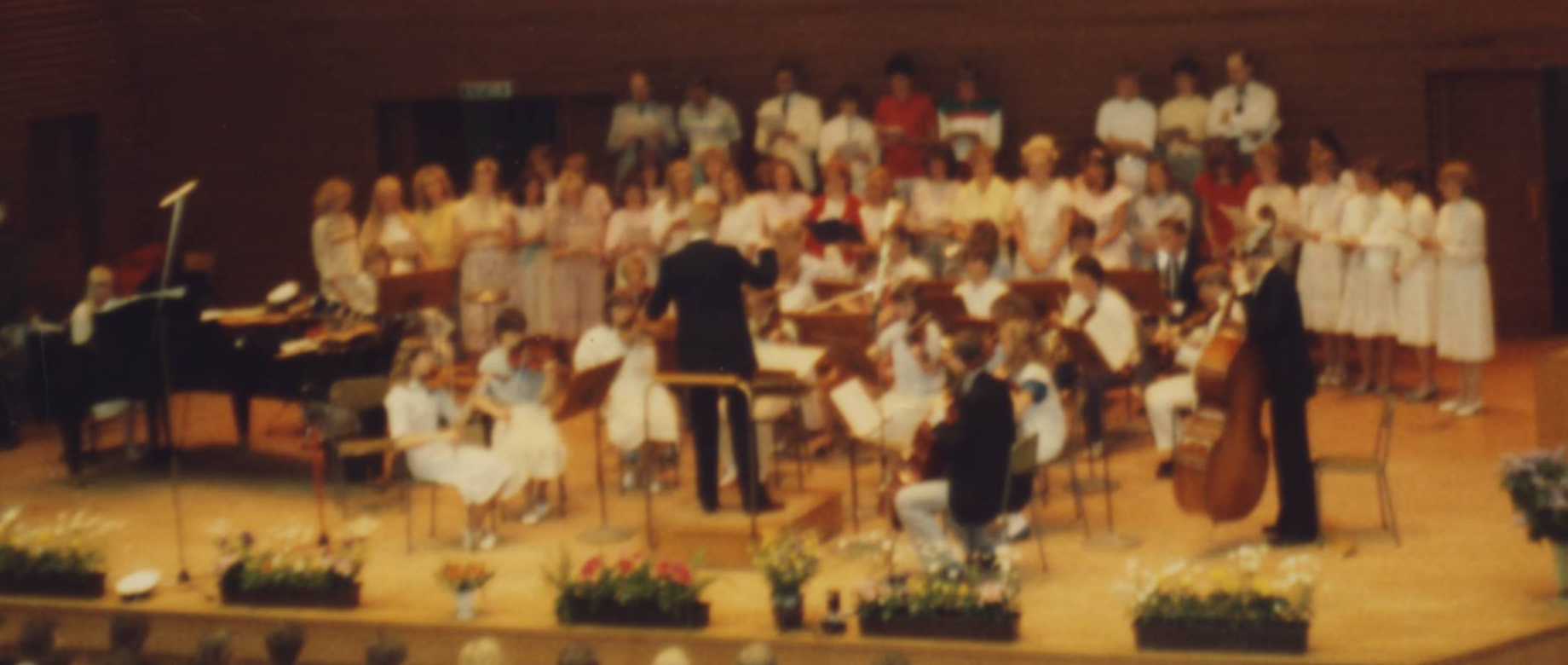— Choral Works
* indicates a withdrawn piece
** indicates juvenilia, withdrawn and not available
Passio [Passio secundum Matthaeum]
Date of composition: Roma, 5 November 2023; revised in April 2024
Text: from the Gospel of Matthew (chapter 26 & 27) from the Latin Vulgate; Ambrose (c. 340–397); Venantius Fortunatus (c. 530–600); Bonaventura (c. 1217–1274); Jacopone da Todi (c. 1230–1306); and from the Catholic Tenebrae Responsories for Maundy Thursday and Good Friday. All texts are in Latin.
Voices: • Three vocal soloists: soprano, mezzo, baritone [Iesus/Jesus]
• Ten soloists from the choir: 2 sopranos [Serva I & II/Maid I & II); 1 mezzosoprano (Serva III/Maid III]; 1 alto [Pilati uxor/Wife of Pilate]; 1 tenor [Iudas Scarioth/Judas Iscariot];4 baritones [Pontio Pilato, Petrus, Duobus testibur/Pontius Pilate, Peter, Two witnesses]; 1 bass [Caiphas/Caiaphas]
• Mixed chorus
Instruments: 2 violas, 2 violoncellos, organ (with at least two manuals and a pedal division with at least one 16 ft stop)
Duration: c. 90 min.
Commissioned by: (in alphabetic order) Carl Johan församling, Göteborg (David Molin); Erik Westbergs vokalensemble, Piteå (Erik Westberg); Kalmar Domkyrka (Jan H. Börjesson); Linköpings Domkyrka (Marie-Louise Beckman); Lunds Domkyrka (Robert Bennesh); Maria Magdalena kyrka, Stockholm (Mats Nilsson); Norrköpings församling (Gunnar Björkvall); Sankt Johannes kyrka, Malmö (Christian Schultze); Uppenbarelsekyrkan, Hägersten (Martin Blomquist); Östersunds församling (Nicklas Strandberg).
Dedication: Dedicata alla Basilica di Santa Sabina all’Aventino a Roma, fonte di ispirazione per la creazione di questa Passio.
Publisher: Swedish Music Information Centre, Stockholm
First performance: Seven first performances during Holy Week, 2024:
• 24 March, Maria Magdalena Church, Stockholm. Lisa Carlioth (soprano), Maria Forsström (mezzo), Carl Ackerfeldt (baritone), Maria Magdalena Motettkör, conducted by Mats Nilsson.
• 24 March, Acusticum, Piteå. Pia-Karin Hellsing (soprano), Katarina Karnéus (mezzo), Anders Eriksson (baritone), Erik Westbergs Vokalensemble, conducted by Erik Westberg.
• 24 March, Hedvigs Kyrka, Norrköping. Sandra Bendrik (soprano), Katarina Böhm (mezzo), Marcus Bartoletti (baritone), S:t Olofs Oratoriekör & S:t Olofs Kammarkör, conducted by Gunnar Björkvall.
• 24 March, Linköpings Domkyrka, Linköping. Elin Skorup (soprano), Katija Dragojevic (mezzo), Staffan Liljas (baritone), Domkyrkans Kammarkör, conducted by Marie-Louise Beckman.
• 24 March, S:ta Birgittas Kapell, Göteborg. Nina Ewald (soprano), Amanda Flodin (mezzo), Arvid Eriksson (baritone), Carl Johans Kammarkör, conducted by David Molin.
• 27 March, Uppenbarelsekyrkan, Hägersten. Jessica Elevant (soprano), Maria Forsström (mezzo), David Risberg (baritone), Uppenbarelsekyrkans Motettkör, conducted by Martin Blomqvist.
• 29 March, Stora Kyrkan, Östersund. Sofia Niklasson (soprano), Maria Forsström (mezzo), Lars Brissman (baritone), Stora Kyrkans Motettkör, conducted by Nicklas Strandberg.
About the piece: This is a Saint Matthew Passion in Latin, that is, an Easter oratorio that retells the story of Jesus’ suffering and death (the passion story) as it is recounted in the Bible by the evangelist Matthew.
…..For a few years I have been living a large part of my time in Rome, where there are more than 900 churches. Even in our modern times, religion has a clear presence in the “Eternal City”. I love going to the oldest churches, such as San Giovanni in Laterano or Santa Maria in Trastevere from the 4th century, Santa Maria Maggiore from the 5th century, or San Lorenzo fuori le mura from the 6th century. When I am there, I listen into the room and music comes to me.
…..My main source of inspiration is Santa Sabina all’Aventino, consecrated around 430 A.D., a classic Roman basilica from the earliest phase of Christian history, before the fall of the Roman Empire. The large cypress wood doors have eighteen carved panels with biblical motifs. One of these is believed to be the first artistic representation of the crucified Jesus flanked by the two robbers.
…..Unfortunately, today there is not much musical life beyond Mass in the Italian Catholic Church in Rome, but it seems to me that these amazing rooms require music to come alive, music that can convey the faith that led to the creation of the Church. A dream was born to write a passion oratorio. Not a passion in the footsteps of J. S. Bach — it is futile to try to compete with the master, but one which, in an ecumenical and timeless spirit, is as conceivable in a Protestant church as in the historic Catholic shrines of Rome.
…..I have compiled a libretto based on chapter 26 and 27 of the Gospel of Matthew in the Latin Vulgate. In addition to this I have added texts by Ambrose of Milan (ca. 340–397), Venantius Fortunatus (ca. 530–600), Giovanni Fidanza di Bonaventura (ca. 1217–1274), and Jacopone da Todi (ca. 1230–1306), as well as from the Catholic Tenebrae Responsories for Maundy Thursday and Good Friday.
…..My intention is that the text should be pronounced in the way that Italians do in the Catholic Church, or when they perform, for example, Verdi’s Requiem, and thus not in a classical (antique) way.
Vier Luther-Variationen, for baritone solo, mixed chorus, and organ
Date of composition: Stockholm, 10 September 2017
Text: Martin Luther (1483–1546), in German
1. Vom Himmel hoch, da komm ich her
2. Nun freut euch, lieber Christen g’mein
3. Komm, Gott Schöpfer, Heiliger Geist
4. Ein feste Burg ist unser Gott
Voices: baritone solo, mixed chorus (S.A.T.B., and double chorus in one movement)
Instrument: organ (written for a large instrument with three manuals, but could be played on two manuals)
Duration: c. 20 min. [5+6,5+4+4 min.]
Commissioned by: Stefan Parkman and Uppsala Universitets Körcentrum (The Choir Centre of Uppsala University)
Dedication: Dedicated to Stefan Parkman
Publisher: Norsk Musikforlag A/S, Oslo, 2018
Score (A4): N.M.O. 14406A / ISMN 979-0-065-16135-8
Organ part (A4): N.M:O. 14406B / ISMN 979-0-065-16136-5
First performance: 29 October 2017, Uppsala Domkyrka (Uppsala Cathedral), Uppsala, Sweden. Uppsala Akademiska Kammarkör, Västerås Domkyrkas Motettkör, Olle Persson (baritone), Johan Hansson Lindström (organ), Stefan Parkman (cond.).
About the piece: Commissioned for the quincentenary of Martin Luther’s Ninety-five Theses, 31 October 1517, the start of the reformation. These chorale variations make use of the texts and melodies of Martin Luther (1483–1546), putting them in an entirely new musical context with a dramatic and narrative approach to the words. The four movements can be performed either as a suite or individually.
Från mars -79, for chorus and organ
Date of composition: Stockholm, 2 December 2013
Text: Tomas Tranströmer (1931–2015), in Swedish
Voices: mixed chorus (S.A.T.B.)
Instrument: organ (written for an instrument with three manuals, but could be played on two manuals)
Duration: ca 4 min.
Commissioned by: Malmö Pastorat (The Parish of Malmö, Sweden)
Dedication: Dedicated to my friend Carl Adam Landström
Publisher: Norsk Musikforlag A/S, Oslo, 2018
N.M.O. 14404 / ISMN 979-0-065-16133-4
First performance: 19 January 2014, Sankt Petri Church, Malmö, Sweden. Sankt Petri Singers, conducted by Alexander Einarsson, and Carl Adam Landström, organ.
About the piece: The music is composed to a poem of Nobel Prize laureate Tomas Tranströmer (1931–2015). In this short and beautiful poem (From March 1979), the author tells how sick he is to hear words without a meaning, words without a language. He travels to a desolate, snowy island, where he sees a line of deer-slots in the snow — a language without words.
The Tyger, for chorus and organ
Date of composition: Stockholm/Siracusa/Roma, 8 August 2012
Text: William Blake (1757–1827), in English
Voices: mixed chorus (S.A.T.B.)
Instrument: organ (written for a large instrument with three manuals, but could be played on two manuals)
Duration: c. 5 min.
Dedication: Commissioned by and dedicated to my dear friend Erik Westberg, for the Erik Westberg Vocal Ensemble
Publisher: Edition Norsk Musikforlag A/S, Oslo, Norway, 2012 (N.M.O.13262)
available on sale:
Score (Chorus and organ, A4), N.M.O.13262A / ISMN 979-0-065-12548-0
Organ part (A4), N.M.O.13262B / ISMN 979-0-065-12549-7
Accordion part (A4), N.M.O.13262C / ISMN 979-0-065-12550-3
First Performance: 5 October 2012, Studio Acusticum, Piteå. The Erik Westberg Vocal Ensemble.
About the piece: In this piece, I bring together two poems of the English poet, painter, and printmaker William Blake (1757–1827), The Tyger (from Songs of Experience, 1794) and The Lamb (from Songs of Innocence, 1789). These poems are written five years apart, but they are in a way related, since Blake refers to the maker of the Lamb in The Tyger. He asks himself whether the creator of the mild, blessed, innocent Lamb really also could have created the fearful Tyger.
…..It is all about the ancient Theodicy, i. e. the question whether a good and allmighty God really exists, when there is so much evil and suffering in the world. Considering all problems and wars that are to be found in the world today, it is still a valid question.
…..The two poems are quite contrasting, which is an advantage musically. The predominating tone is restless and tempestuous, based on The Tyger. The poem The Lamb, which has inspired to slower and milder music, appears directly after the fifth verse of The Tyger, where the lamb in mentioned. After that, the stormy music returns and concludes the piece.
…..The music is written for mixed chorus and a large symphonic (romantic) organ with three manuals, but it could also be played on a two manual instrument. In order to facilitate the execution of the organ part (to make it easier to read and to reduce the number of page turns that would occur if it is played from the score), a separate organ part is available from the publisher.
…..There is also an arrangement for accordion, to replace the organ, in the form of a separately published accordion part. The chorus and the conductor make use of the same score (chorus and organ) in both cases.

– Click on the image for a larger view
A Christmas Gloria, for chorus, organ and orchestra
Date of composition: Stockholm/Sicilia (Cefalù), 3 September 2009
Text: Latin texts, partly from Piae Cantiones (1582)
Voices: children’s chorus (unison), youth chorus (S.S.Mz.), mixed chorus (S.A.T.B.)
Instrumentation: 2.2.2.2 / 4.2.3.1 / timp, glsp, hp, org / str
– The organ has a soloistic role and should be a large romantic pipe organ with 16ft-stops on the manuals and 32ft-stops in the pedal.
Duration: 13 min.
Commissioned by: Sankt Matteus Församling (The Parish of Saint Matthew), Stockholm
Publisher: Edition Norsk Musikforlag A/S, Oslo, Norway, 2009 (N.M.O.12928)
available on sale:
Study score (A4), N.M.O.12928A / ISMN 979-0-065-12167-3
Vocal score, with piano reduction (A4), N.M.O.12928B / ISMN 979-0-065-12168-0
available on hire:
Conductor’s score (A3), N.M.O.12928C / ISMN 979-0-065-12169-7
Orchestral parts (B4), N.M.O.12928D / ISMN 979-0-065-12170-3
 First performance: 12 & 13 December 2009 (four concerts), St. Matteus Church, Stockholm. St. Matteus Symphony Orchestra, the choirs of St. Matteus Church, Anders Frisk (organ), Sonny Jansson (cond.)
First performance: 12 & 13 December 2009 (four concerts), St. Matteus Church, Stockholm. St. Matteus Symphony Orchestra, the choirs of St. Matteus Church, Anders Frisk (organ), Sonny Jansson (cond.)
About the piece: Some of the old songs used in A Christmas Gloria are taken from Piae Cantiones, a song book of 74 sacred non-liturgical Latin songs, published in Åbo (nowadays a part of Finland, in those days a part of Sweden), in 1582.
xxxFirst of all Personent hodie, a merry song, describing the little child Jesus lying in his crib, urging us to sing ‘Gloria in excelsis Deo’. The second song is Omnis mundus jucundetur, an exhilarated song, enthusiastically telling us that all the world must rejoice, because our Saviour is born.
 xxxThe third song, In dulci jubilo, was very popular all over Europe. The original words were written half in German and half in Latin, a so called ‘Latin macaronic’ text. Here I give three text versions; the Swedish-Latin version from Piae Cantiones, the English-Latin version of George Ratcliffe Woodward (1848–1934), and, finally, the original German-Latin version of Peter von Dresden (approx. 1350–1425).
xxxThe third song, In dulci jubilo, was very popular all over Europe. The original words were written half in German and half in Latin, a so called ‘Latin macaronic’ text. Here I give three text versions; the Swedish-Latin version from Piae Cantiones, the English-Latin version of George Ratcliffe Woodward (1848–1934), and, finally, the original German-Latin version of Peter von Dresden (approx. 1350–1425).
xxxO Sanctissima is a Sicilian hymn in Latin to the Blessed Virgin Mary, sometimes called ‘Sicilian Mariners Hymn’, and Adeste Fideles has its roots in a (probably) Portuguese hymn in Latin from the 13th century, with a hymn tune of John Frances Wade (1722–86).
xxxAs a ritornello in the piece, I make use of the ‘Gloria in excelsis Deo’ from the Christmas carol Angels We Have Heard on High, and I also use fragments from The First Nowell, as an orchestral interlude.
|
Lyssna på ljudklipp (mp3)
A Song of Joys, for male chorus, solo voice and percussion
 Date of composition: Stockholm, 16 January 2005
Date of composition: Stockholm, 16 January 2005
Text: Walt Whitman (1819–92): When I Heard at the Close of the Day & from A Song of Joys (English)
Voices: male chorus (T.T.B.B.) and solo voice (mezzo or baritone)
– Percussion instruments (one player): tubular bells, vibraphone, two low Thai gongs in A-flat and B-flat.
Duration: 9 min.
Dedication: To my dearest friend Magnus Svensson
Commissioned by: Orphei Drängar, a male chorus in Uppsala, Sweden
Publisher: Edition Norsk Musikforlag A/S, Oslo, 2008 (N.M.O.12590)
available on sale:
Score/Choral score (A4), N.M.O.12590A / ISMN 979-0-065-11727-0
Percussion part (A4), N.M.O.12590B
First performance: 23 April 2005, Uppsala University Auditorium. Orphei Drängar (chorus), Katarina Leoson (mezzo), Markus Leoson (perc.), Robert Sund (cond.)
About the piece: A Song of Joys was commissioned by the male chorus Orphei Drängar in Uppsala for their Spring concerts 23—24 April 2005. In this concert the musician couple Katarina Nilsson and Markus Leoson were guest soloists, so the chorus wanted a piece which incorporated both of them. The words used in A Song of Joys are drawn from two different poems of the American poet Walt Whitman (1819–1892). These two poems (the love poem When I Heard at the Close of the Day and excerpts from A Song of Joys) are superimposed in a way that binds them together. The love poem is sung by the solo voice alone and the other poem mainly by the male choir but in the end also by the soloist.
Lyssna på ljudklipp (mp3)
Kyssar vill jag dricka, for mixed chorus a cappella
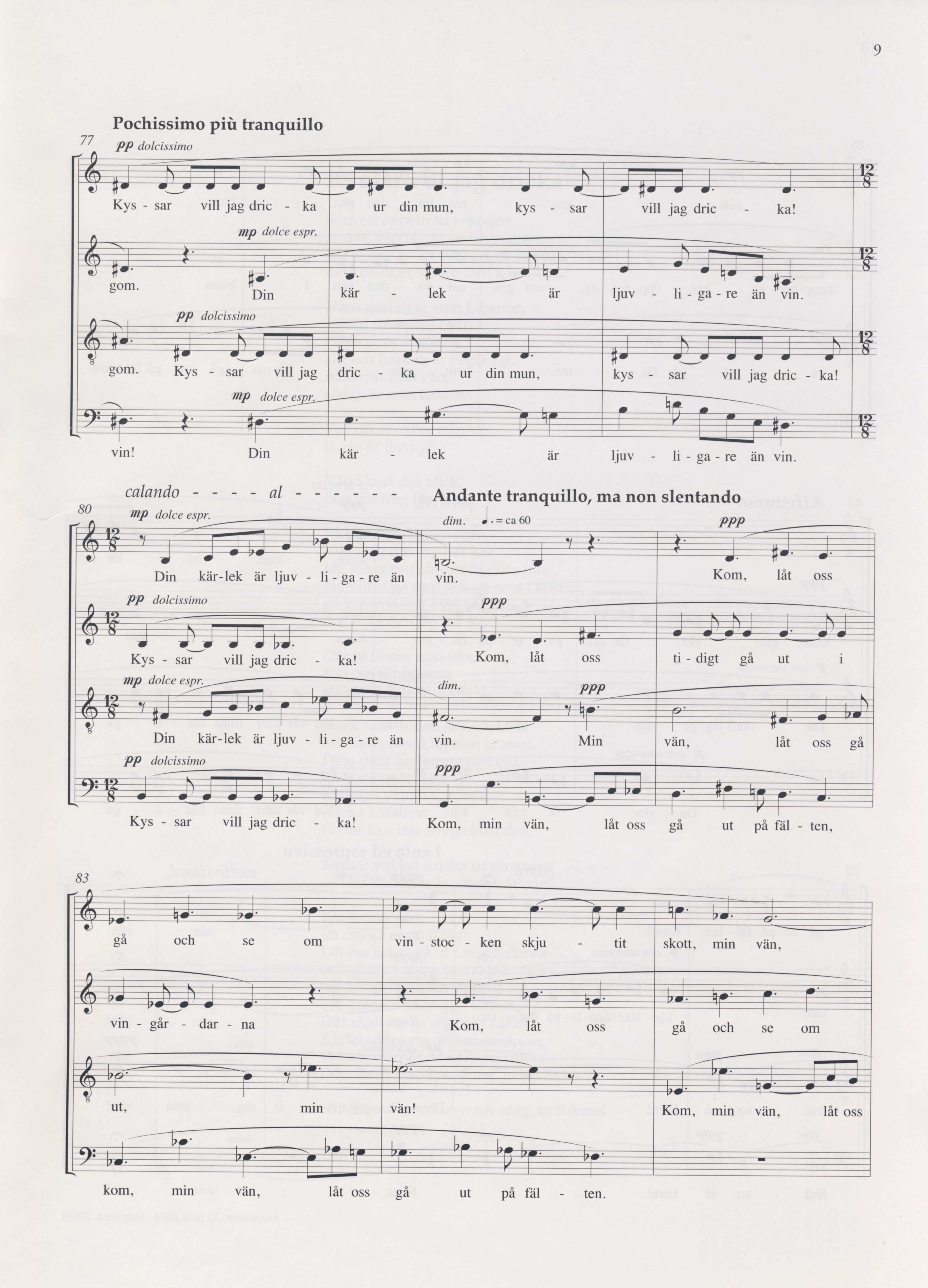 Date of composition: Stockholm, 20 June 2004
Date of composition: Stockholm, 20 June 2004
Text: from The Song of Songs, from the Holy Bible, in Swedish
Voices: mixed chorus (S.A.T.B.)
Duration: 6 min.
Dedication: To Peter Svensson
Publisher: Edition Norsk Musikforlag A/S, Oslo, 2008
N.M.O.12569 / ISMN 979-0-065-11699-0
First performance: 28 January 2005, Kongsberg, Norway. Ensemble Notus, Olof Boman (cond.)
Recording: Phono Suecia PSCD 178 (released 2009). Ensemble Notus, Olof Boman (cond.)
About the piece: The text is a compilation of verses from The Song of Songs (the Bible), in Swedish. It is a tribute to carnal desire, not a sacred choir piece, and I have been quite free in my way of using the verses.
…..Since these poems originate from an ancient, Oriental setting, I studied some anthologies on Arabian music and have incorporated some significant features in the mode that is used in the piece, like the two augmented seconds; E-flat/F-sharp and A-flat/B natural.
Lyssna på ljudklipp (mp3)
Sonnet XVIII, for mixed chorus a cappella
 Date of composition: Stockholm, 22 June 2002
Date of composition: Stockholm, 22 June 2002
Text: William Shakespeare (1564–1616), in English
Voices: mixed chorus (S.A.T.Bar.B.)
Duration: 4 min.
Dedication: To my dearest friend Olof Boman
Commissioned by: Stockholms Motettkör
Publisher: Edition Norsk Musikforlag A/S, Oslo, 2008
N.M.O.12570 / ISMN 979-0-065-11700-3
First performance: 25 October 2002, Nybrokajen 11, Stockholm. Stockholm Motet Choir, Olof Boman (cond.)
Recording: Phono Suecia PSCD 178 (released 2009). Swedish Radio Choir, Peter Dijkstra (cond.)
About the piece: This piece was commissioned by the choir Stockholms Motettkör and it was premiered at their 30th Anniversary Concert at Nybrokajen 11 in Stockholm, 25 October 2002. The words are from Sonnet No. 18 of William Shakespeare (1564–1616), Shall I Compare Thee to a Summer’s Day.
||
|
Lyssna på ljudklipp (mp3)
Kom, gryende dag, for mixed chorus a cappella
Date of composition: Rättvik, 25 April 1988
Text: Atle Burman, in Swedish
Voices: mixed chorus (S.A.B.)
Duration: 3 min.
Du gav din ande röst, for mixed chorus a cappella
Date of composition: Rättvik, 25 April 1988
Text: Birgitta Wennerberg-Berggren, in Swedish
Voices: mixed chorus (S.A.B.)
Duration: 3 min.
Te Deum, for baritone, mixed chorus, percussion, 2 violas, 2 violoncellos, and organ
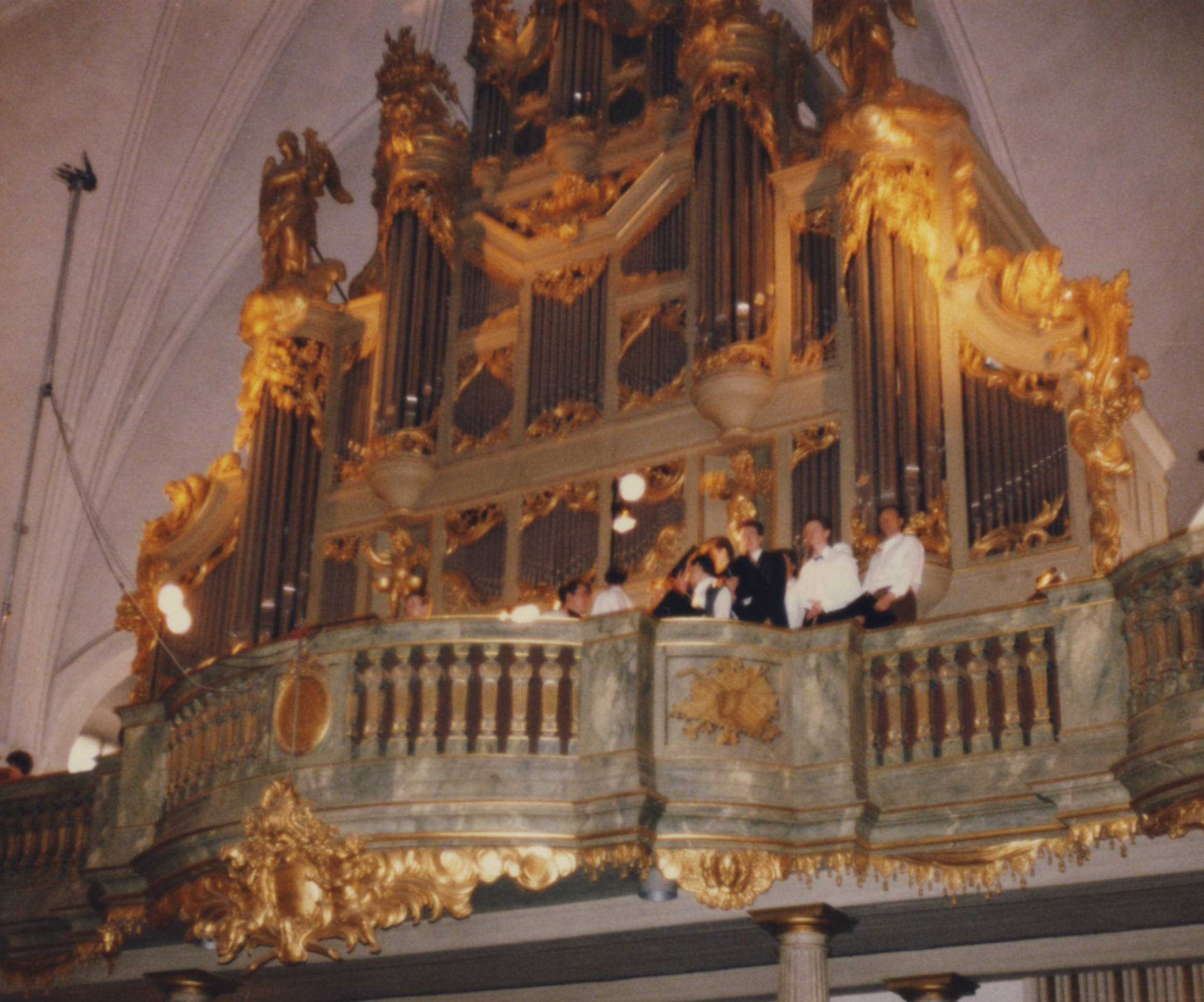 Date of composition: Sjömarken/Stockholm, 8 August 1987
Date of composition: Sjömarken/Stockholm, 8 August 1987
Text: Te Deum Sequenza (Latin, 5th Century) and ”Oficio”, a poem by the Chilean poet Adrián Santini, translated into Swedish by Eva M. Ålander: ”Tjänsteutövning”
Voices: mixed chorus (S.A.T.B.) and baritone solo
Instruments: 2 violas, 2 violoncellos, large organ, 4 percussionists (I & II on the left side of the organ, III & IV on the right side).
– Percussion instruments: Perc. I: vibraphone, side drum, large bass drum, 5 Chinese temple-blocks, suspended cymbal, medium tam-tam, 2 tubular bells (in B natural, C); Perc. II: 3 timpani, clashed cymbals, tenor drum, wood-block, logdrum with two pitches, 5 brake-drums, crotales; Perc. III: clashed cymbals, medium bass drum, 5 tom-toms, 3 gongs (in D, E, F-sharp), glockenspiel; Perc. IV: marimba, 2 bongos, suspended cymbals, side drum, tambourine, large tam-tam, 2 tubular bells (in G, A), 3 gongs (in D, E, F-sharp; same instruments as Perc. III).
Duration: 30 min.
Commissioned by: Katarina Church, Stockholm and Lars-Ewe Nilsson
Publisher: Swedish Music Information Centre, Stockholm
First performance: 10 April 1988, Katarina Church, Stockholm. Per-Olof Wenngren (bar), Capella Catharinae (chorus), Mattias Wager (org.), Joakim Anterot, Björn Persson, Markus Leoson, Roger Bergström (perc.), Magnus Wassenius, Karin Dungel (vla.), Magnus Lanning-Ekenborn, Cecilia Glaser (vlc.), B.Tommy Andersson & Jonas Dominique (cond.)
About the piece: The chorus (Latin text only) should be placed on the organ loft, together with the percussion and the organ, invisible to the audience. The solo voice (Swedish text only) and the strings should be in front of the audience and might need a separate conductor, unless it is performed as chamber music.

Du som är… , for women’s chorus, solo viola, and organ
Date of composition: Sjömarken/Stockholm, 5 September 1986
Text: Dag Hammarsköld (1905–61), in Swedish
Voices: women’s chorus (S.S.A.) with a solo soprano voice
Instruments: solo viola and large organ
Duration: 17 min.
Dedication: To Immanuelskyrkan’s Chamber Choir, Stockholm
Commissioned by: Immanuelskyrkan, Stockholm
Publisher: Swedish Music Information Centre, Stockholm
First performance: 23 November 1986, Immanuelskyrkan, Stockholm. Peter Eriksson (vla.), Thore Kennestad (org.), Immanuelskyrkan’s Chamber Choir, B.Tommy Andersson (cond.)
Stabat Mater, for women’s chorus, violoncello, and doublebass
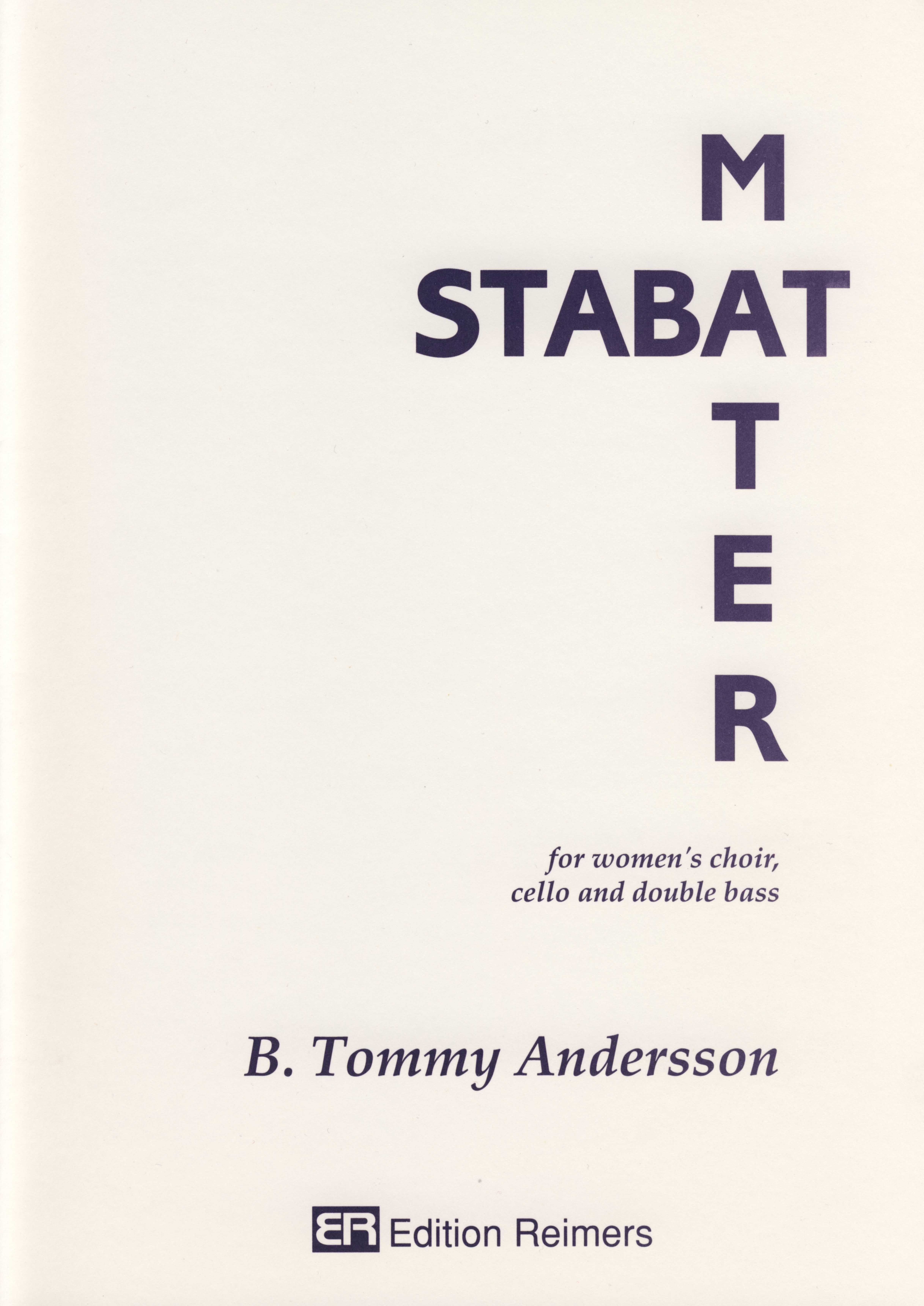 Date of composition: Stockholm/Sjömarken, 26 December 1985
Date of composition: Stockholm/Sjömarken, 26 December 1985
Text: Jacopone da Todi (c. 1230–1306), in Latin
Voices: women’s chorus (S.S.A.) with a solo soprano voice
Instruments: solo violoncello and solo doublebass
Duration: 12 min.
Commissioned by: The Girl’s Chorus of Katarina Church and their conductor Lars-Ewe Nilsson
Publisher: Edition Reimers, Stockholm, 1990 (ER 103094)
First performance: 6 February 1986, Katarina Church, Stockholm. Katarina Church Girls’s Chorus, Magnus Lanning-Ekenborn (vlc.), Primus Prevorcek (db.), Lars-Ewe Nilsson (cond.)
Lyssna på ljudklipp (mp3)
* Vindar [Winds], for solo voice, mixed chorus, and orchestra
Date of composition: Sjömarken, 4 January 1983
Text: Erik Lindegren (1910–68), from ”Vignetter”, in Swedish
1. Vinden (The Wind)
2. Drömmen (The Dream)
3. Skytisk vår (Scythian Spring)
4. Ängen (The Meadow)
Voices: soprano solo, mixed chorus (S.A.T.B.)
Instrumentation: 2.0.3*.0 / 2.1.1.0 / alto horn in E flat / 2 perc, pno, org / str
[bass clarinet]
– Percussion instruments: triangle, clashed cymbals, suspended cymbal, 2 side drums (one with and one without snares), bass drum.
Duration: 18 min.
Dedication: To Jan Reinholdsson
First performance: 9 June 1983, the auditorium of Bäckängskolan, Borås. Annelie Brunegård (soprano), singers and musicians from Bäckängskolan, B.Tommy Andersson (cond.)
* Missa Brevis, for mixed chorus a cappella
Date of composition: Sjömarken, Spring 1983
Text: from the Catholic mass (Latin)
1. Kyrie
2. Gloria
3. Agnus dei
Voices: mixed chorus (S.A.T.B.)
Duration: 18 min.
Hjärtstilla [Motherwort], for mixed chorus a cappella
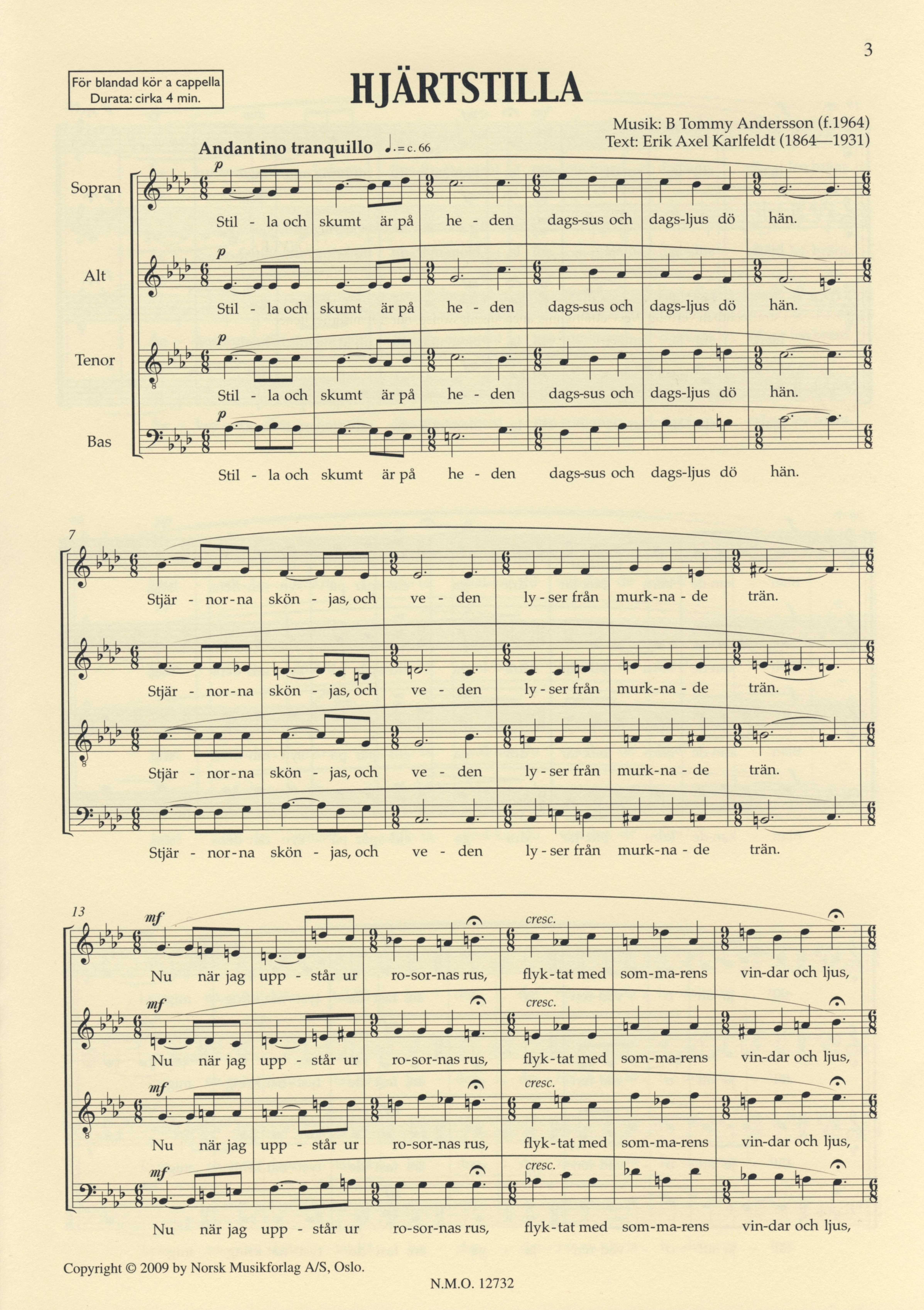 Date of composition: Sjömarken, 21 May 1982, revised 11 January 2009
Date of composition: Sjömarken, 21 May 1982, revised 11 January 2009
Text: Erik Axel Karlfeldt (1864–1931), in Swedish
Voices: mixed chorus (S.A.T.B.)
Duration: 6 min.
Publisher: Edition Norsk Musikforlag A/S, Oslo, 2009
N.M.O.12732 / ISMN 979-0-065-11919-9
First Performance: 19 April 2009, Grünewaldsalen, Stockholm Concert Hall. Ensemble Notus, Olof Boman (cond.)
|
|
Lyssna på ljudklipp (mp3)
|
Nachts, for male chorus a cappella
 Date of composition: Sjömarken, 28 June 1981, revised 12 January 2009
Date of composition: Sjömarken, 28 June 1981, revised 12 January 2009
Text: Joseph von Eichendorff (1788–1857), in German
Voices: male chorus (T.T.B.B.)
Duration: 3 min.
Publisher: Edition Norsk Musikforlag A/S, Oslo, 2009
N.M.O.12733 / ISMN 979-0-065-11920-5
First Performance: 19 April 2009, Grünewaldsalen, Stockholm Concert Hall. Ensemble Notus, Olof Boman (cond.)
|
|
|
|
|
Lyssna på ljudklipp (mp3)
Jungfru Maria i rosengård, for mixed chorus and piano
[Virgin Mary in a Rose-Garden]
Date of composition: Sjömarken, 11 March 1981
Text: Viktor Rydberg (1828–95), in Swedish
Voices: small mixed chorus or vocal ensemble (S.A.B.)
Duration: 7 min.
Commissioned by: Margareta Skyllberger
First performance: May 1981, Sandared Church. A Vocal Ensemble, Margareta Skyllberger (leader and piano).
Lyssna på ljudklipp (mp3)
** In gloria patris
Date of composition: Sjömarken, Spring 1980
Text: Sanctus and Benedictus from the Catholic mass (Latin)
Voices: double chorus (S.A.T.B. + S.A.T.B.), solo voices (soprano, mezzo, baritone) and children’s chorus, a cappella.
Duration: c. 12 min.
** Cantata, for mixed chorus, solo voices, and organ
Date of composition: Sjömarken, Autumn 1979
Text: from the Holy Bible [Luk. 21:5—36] (Swedish)
1. Chorus
2. Recitative (tenor solo, bass solo)
3. Aria (bass solo)
4. Recitative (alto solo)
5. Aria (soprano solo)
6. Chorale
Voices: mixed chorus (S.A.T.B.), solo voices (soprano, alto, tenor, bass)
Duration: c. 15 min.
Commissioned by: Lars-Erik Bernvill
** Vad vet vi? [What do we know?], for women’s chorus and piano
Date of composition: Sjömarken, Spring 1979
Text: Pia Andersson
Voices: two-part women’s chorus (S.A.)
Duration: 5 min.
** Vintern [The Winter], for solo voices, mixed chorus, and orchestra
Date of composition: Sjömarken, 29 April 1978
Text: B. Tommy Andersson
Voices: mixed chorus (S.A.T.B.), solo voices (soprano, tenor, baritone), children’s chorus
Instrumentation: 2.2.0.2 / 0.0.0.0 / str
Duration: c. 15 min.

